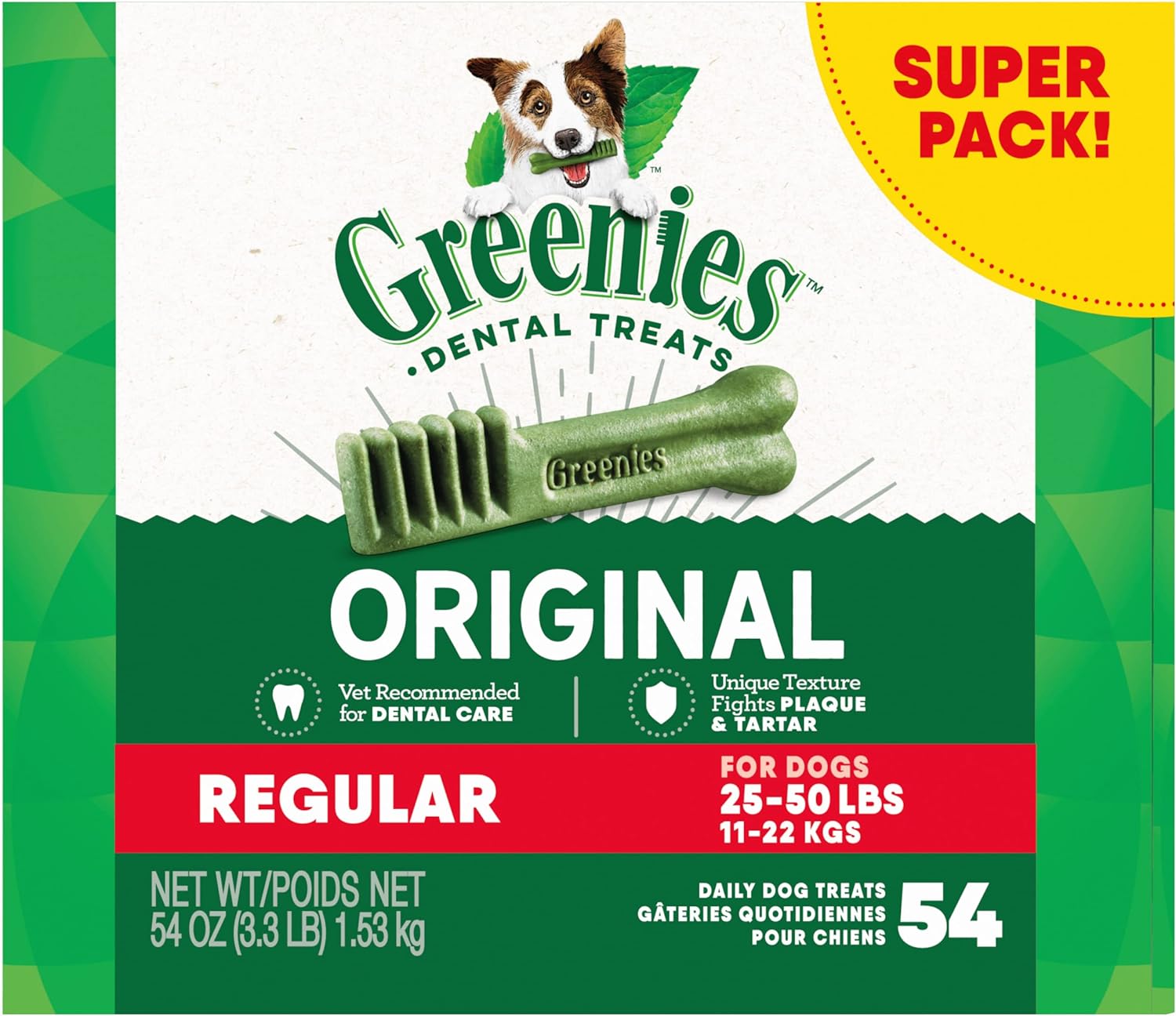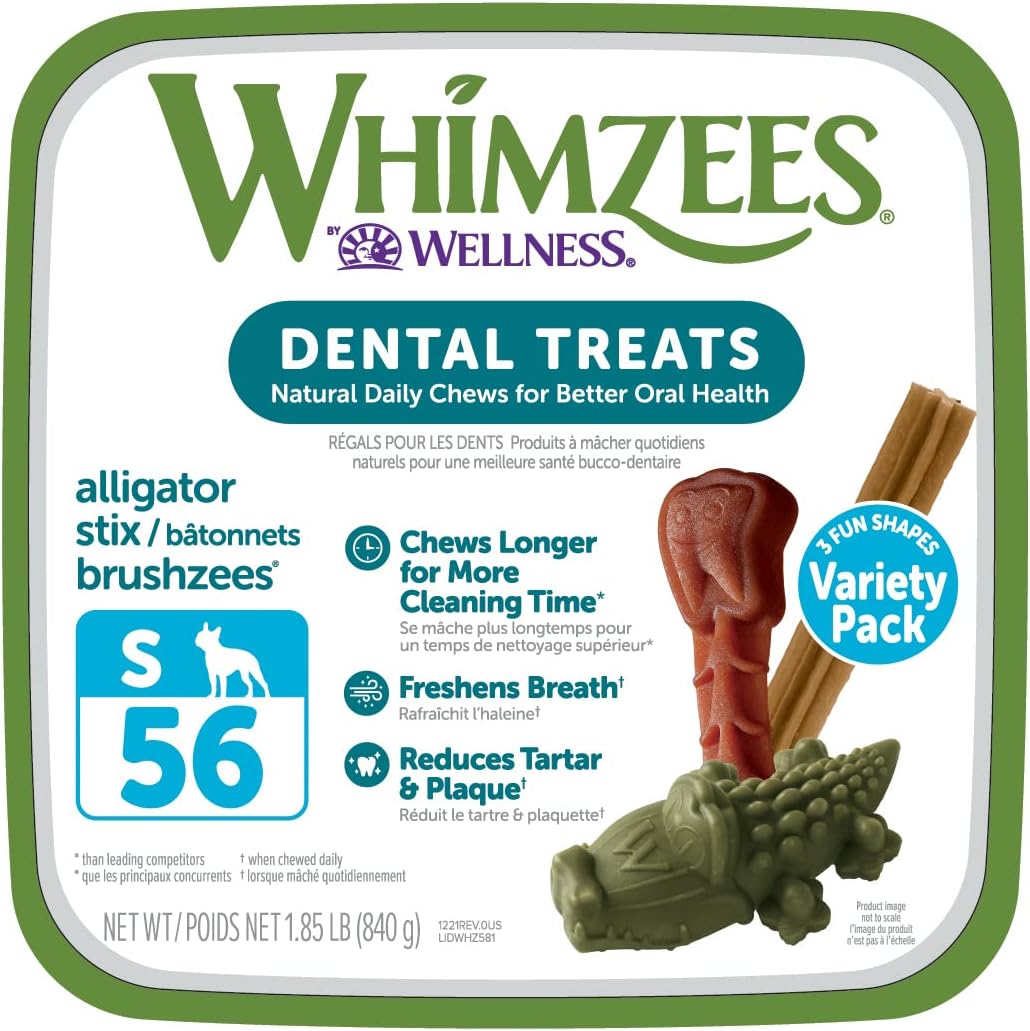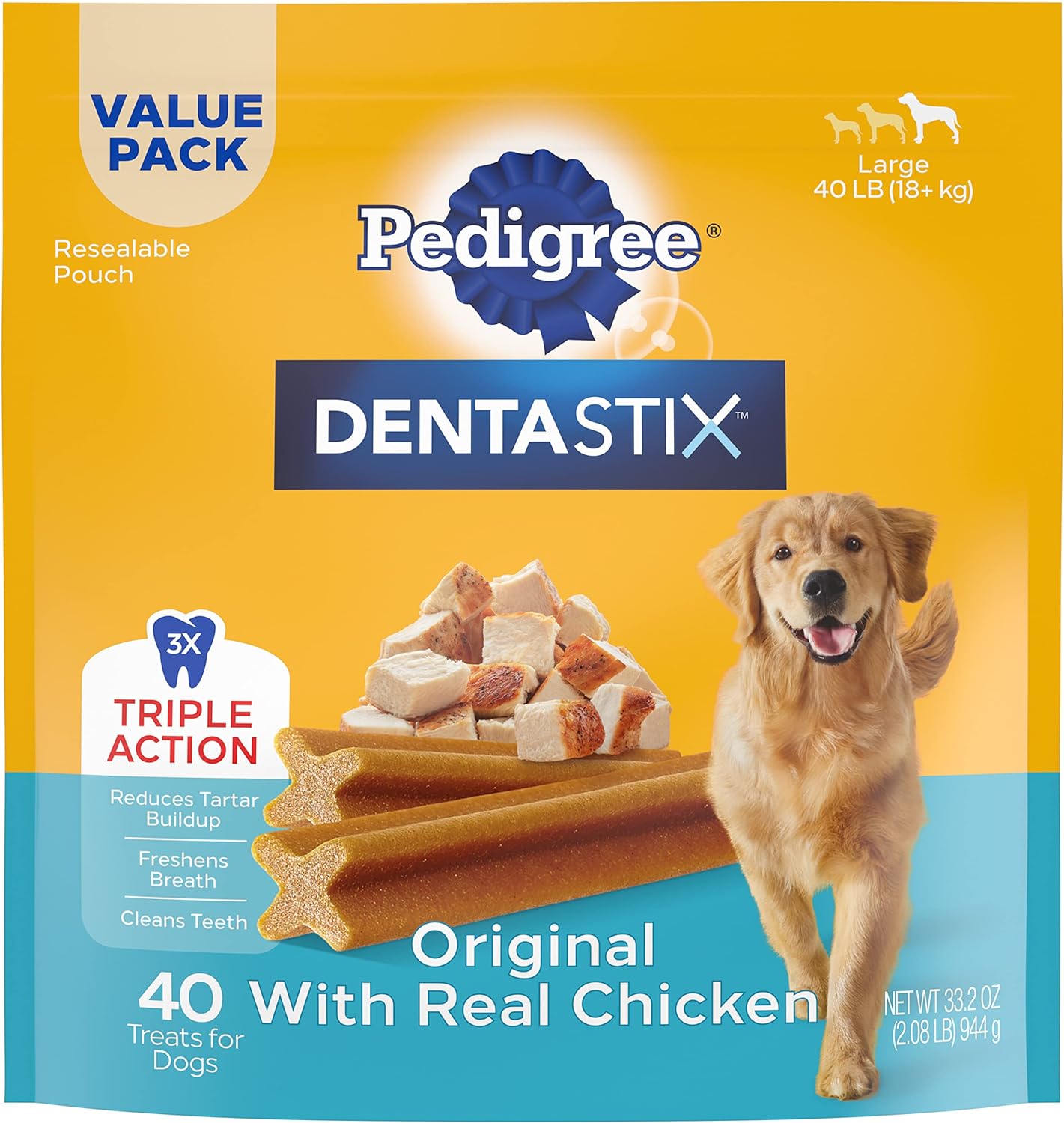I'm a participant in the Amazon Services LLC Associates Program, an affiliate advertising program designed to provide a means for me to earn fees by linking to Amazon.com and affiliated sites.
Want to know how to brush dog teeth? Good dental hygiene is crucial for dogs, much like it is for humans. This comprehensive guide will walk you through the steps and tips for maintaining your dog’s dental health, which can prevent many health issues and lead to a happier, healthier life for your furry friend.
Feature | |||
|---|---|---|---|
Ingredients | Wheat-based (grain-free available) | Vegetarian, grain-free | Rice Flour (grain-free options available) |
Textural Design | Toothbrush-like | Unique shapes | X-shaped |
VOHC Approval | Yes | Yes | Yes |
Flavor Variety | Extensive | Limited | Chicken, Beef, Mint |
Special Formulas | Yes (life-stage and dietary) | No | Grain-free |
Key Takeaways – How to Brush Dog Teeth
- Begin Early: Start dental care routines with your dog as early as possible.
- Choose Right: Use toothbrushes and toothpaste made specifically for dogs.
- Brush Regularly: Aim to brush your dog’s teeth daily, or at least several times a week.
- Seek Alternatives: Consider dental chews, wipes, and toys if brushing is difficult.
- Professional Help: Schedule regular dental checkups and cleanings with your vet.
- Diet Matters: Incorporate dental-friendly diets and toys into your dog’s routine.
Getting Started with Dog Dental Care
Understanding how to properly brush your dog’s teeth is essential for preventing oral diseases and keeping your pet healthy. Start by choosing the right toothbrush and toothpaste specifically designed for dogs. Human toothpaste can be harmful to your pet, so it’s important to use products formulated for dogs. Introduce your dog gradually to the toothpaste and brush, allowing them to sniff and taste the toothpaste before you begin brushing.
Techniques for Brushing Your Dog’s Teeth
The technique for brushing your dog’s teeth isn’t overly complex but does require consistency. Lift your dog’s lips to gently brush the teeth in a circular motion, focusing on the gum line where plaque tends to accumulate. It’s best to brush your dog’s teeth daily, but even a few times a week can make a significant difference in their oral health.
Alternatives to Brushing
For dogs that resist tooth brushing or for owners who find the daily routine challenging, there are alternatives. Dental wipes, oral rinses, and specially formulated dental chews can help reduce plaque and tartar buildup. These products can be a good complement to brushing, or an alternative when regular brushing isn’t feasible.
Feature | |||
|---|---|---|---|
Ingredients | Wheat-based (grain-free available) | Vegetarian, grain-free | Rice Flour (grain-free options available) |
Textural Design | Toothbrush-like | Unique shapes | X-shaped |
VOHC Approval | Yes | Yes | Yes |
Flavor Variety | Extensive | Limited | Chicken, Beef, Mint |
Special Formulas | Yes (life-stage and dietary) | No | Grain-free |
Professional Care and Regular Checkups
Regular veterinary checkups should include a dental examination. Sometimes, a professional cleaning under anesthesia may be necessary, especially if your dog has significant tartar build-up or dental issues. These cleanings can be costly, but they are crucial for maintaining your dog’s dental and overall health.
Incorporating Diet and Toys for Dental Health
Certain diets and chew toys are designed to reduce plaque and strengthen teeth. Discuss with your vet the best food and toys that can contribute to your dog’s dental health. These can serve as additional tools in your arsenal against dental diseases.
For those interested in dog safety and gear, don’t miss out on valuable insights from articles such as Top 5 Best Life Jackets for Corgis and Ruffwear Flagline vs Webmaster: Best Rough Wear Dog Harness. Also, for tracking your pet’s location and activity, explore options like Tractive vs Airtag: Best Pet Tracker for Cats and Dogs.
Detailed Questions and Answers on Dog Dental Care
1. Why is dental care important for dogs?
Dental care for dogs is critical as it helps prevent various oral diseases, including gingivitis and periodontitis, which can lead to more severe health issues. Poor dental hygiene in dogs can result in plaque buildup, which hardens into tartar, potentially causing inflammation and pain. If left untreated, this can lead to tooth loss and infections that might spread to other parts of the body, including vital organs like the heart and kidneys.
Regular dental care ensures that your dog’s mouth remains healthy, free from bad breath, and without painful infections. It also contributes to their overall well-being, as dental pain can affect a dog’s mood and behavior, making them less interactive and more irritable. Proactive dental care can thus enhance the quality of life for your pet, ensuring they remain active and happy.
Moreover, establishing a routine of regular dental care from a young age helps inculcate good habits, making it easier for your dog to accept tooth brushing as a part of their daily routine. Educating pet owners about the importance of dental care is essential, as many tend to overlook this aspect of pet health. By understanding the link between dental health and overall health, owners can take more responsible steps towards caring for their pets.
- Dental care prevents diseases like gingivitis and periodontitis.
- It helps avoid bad breath, infections, and potential organ damage.
- Regular dental routines improve a dog’s overall quality of life and behavior.
2. How often should a dog’s teeth be professionally cleaned?
Professional dental cleanings are recommended at least once a year for most dogs, but the frequency can vary depending on the dog’s breed, age, and overall dental health. Some breeds with particular dental challenges, like small breeds and those with crowded teeth, might require more frequent cleanings. Regular vet check-ups will help determine the appropriate schedule based on the specific needs of the dog.
During a professional cleaning, veterinarians are able to perform procedures that cannot be done at home, such as removing tartar below the gum line and other advanced dental treatments. These cleanings are performed under anesthesia, which allows a thorough and safe cleaning and examination of all tooth surfaces and the gum line. This is critical for preventing periodontal disease, which is not only painful but can also lead to more serious health issues.
Veterinarians also use this opportunity to assess the overall oral health of the dog and can identify any problems early on, such as broken teeth or infections, which might not be visible without professional equipment. Early detection and treatment can prevent more severe problems and also reduce the long-term costs associated with dental diseases. It is vital for dog owners to follow the vet’s recommendations on dental cleanings to ensure their pets remain in good health.
- Annual professional cleanings are generally recommended.
- Some breeds may require more frequent cleanings due to specific dental needs.
- Professional cleanings allow for comprehensive oral health checks and problem prevention.
3. What are some signs of dental problems in dogs?
Signs of dental problems in dogs can range from subtle to obvious. One of the first signs might be bad breath, which is not normal and often indicates plaque build-up or gingivitis. Other signs include visible tartar on the teeth, red or swollen gums, and difficulty eating or a change in eating habits.
More severe symptoms may include pawing at the mouth, drooling more than usual, and visible discomfort while chewing. Some dogs may also exhibit lethargy or a reluctance to play with chew toys, which can indicate oral pain. If a dog suddenly drops food from their mouth or shows a preference for softer foods, this may also be a sign of dental issues.
It is crucial for dog owners to regularly check their dog’s mouth for any signs of dental problems and to seek veterinary care if any abnormalities are noticed. Early intervention is key to managing dental issues effectively and can prevent more serious health complications. Ignoring these signs can lead to advanced periodontal disease and potentially significant systemic health problems.
- Bad breath, visible tartar, and swollen gums are early signs of dental issues.
- Behavioral changes like reluctance to chew and drooling can indicate oral discomfort.
- Regular oral inspections and early veterinary intervention are crucial.
4. Can diet influence a dog’s dental health?
The diet can significantly influence a dog’s dental health. Certain types of food, especially soft or sticky foods, can contribute to the buildup of plaque and tartar. On the other hand, diets formulated to promote dental health, which may include kibbles designed to mechanically clean the teeth or ingredients that reduce plaque formation, can be beneficial.
Chew toys and dental treats can also play a role in maintaining good dental health by mechanically removing plaque from the teeth. It’s important to choose products that are specifically designed for dental care, as not all toys and treats have the same effect. Regular chewing of appropriate toys and treats can help keep the teeth cleaner and reduce the risk of dental disease.
In addition to mechanical cleaning, some diets and treats contain additives that help reduce plaque and tartar or improve overall dental health. Consulting with a veterinarian about the best dietary options for dental care can provide tailored advice based on the specific needs and health of the dog. Proper nutrition combined with good dental care routines can significantly impact the prevention of dental issues.
- Diet impacts dental health, with certain foods increasing plaque buildup.
- Specially formulated diets and dental chews can help maintain dental health.
- Consultation with a vet can guide the best dietary choices for dental care.
- Mechanical cleaning from specific diets and treats helps reduce plaque and tartar.
5. How do you introduce tooth brushing to a dog who has never had it done before?
Introducing tooth brushing to a dog who is not accustomed to it requires patience and gradual training. Start by allowing your dog to get used to the taste of the toothpaste, which should be formulated for dogs. You can do this by placing a small amount on your finger and letting your dog lick it off. This step helps the dog associate the flavor of the toothpaste with a positive experience.
Next, introduce the toothbrush without any toothpaste on it, letting your dog sniff and lick it. You might also gently touch the brush to your dog’s teeth and gums without making brushing movements. This allows the dog to get comfortable with the feeling of the brush. It’s important to keep these sessions short and positive, with plenty of praise and treats.
Once your dog is comfortable with both the toothpaste and toothbrush, begin brushing a few teeth at a time. Start with the front teeth and gradually work your way to the back of the mouth. Make sure to brush gently in a circular motion along the gumline. Consistency is key—try to make tooth brushing a part of your dog’s daily routine, ideally at the same time each day, to build a habit.
- Start with letting your dog taste the toothpaste.
- Introduce the toothbrush gradually, allowing your dog to become comfortable with it.
- Begin brushing gently, starting with a few teeth and progressively increasing.
FAQ on Dog Dental Care
- What type of toothbrush should I use for my dog? Use a toothbrush designed specifically for dogs; these often have softer bristles and a more appropriate size and shape for a dog’s mouth.
- How long does it take to brush a dog’s teeth? It typically takes about 1-2 minutes to effectively brush a dog’s teeth, focusing on all surfaces and the gumline.
- Is it really necessary to brush my dog’s teeth daily? Yes, daily brushing is ideal as it prevents the buildup of plaque and maintains overall dental health.
- What should I do if my dog resists tooth brushing? If your dog resists, go back a step in the training process to ensure they are comfortable, and always use positive reinforcement like praise and treats.
- Can dental chews replace brushing? While dental chews can help reduce plaque and tartar, they should not replace brushing but rather complement it.
- What are the signs that my dog might need professional dental cleaning? Signs include bad breath, plaque buildup, inflamed gums, and changes in eating habits.
- How often should I replace my dog’s toothbrush? Replace your dog’s toothbrush every three to four months, or sooner if the bristles become worn.
- What happens if dental issues in dogs go untreated? Untreated dental issues can lead to severe oral pain, infections, and can even affect overall health by spreading to organs like the heart.
- Are there any risks associated with professional dental cleanings for dogs? While there are minimal risks associated with anesthesia during cleaning, the benefits of preventing serious dental diseases far outweigh them.
- Can puppies have their teeth brushed? Yes, you can start brushing a puppy’s teeth as soon as they have their permanent teeth, around 6 months old, to establish good habits early.



